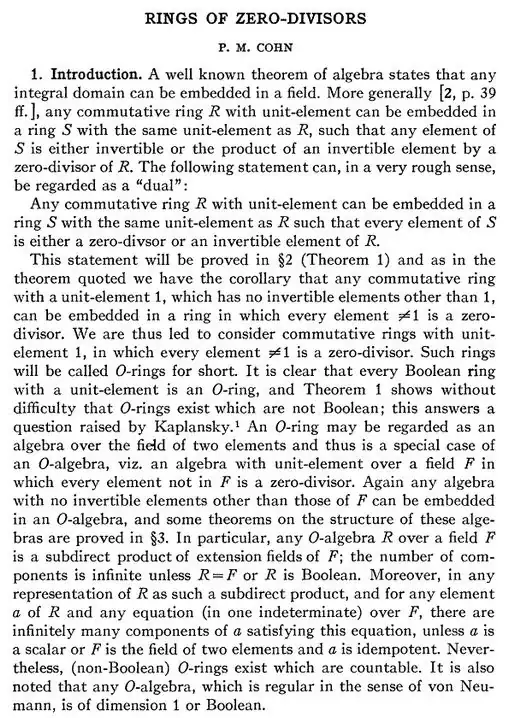I'm assuming you are trying to ask:
Let $A$ be a commutative ring, and let $a\in A$ be an element that is neither a unit, nor a zero divisor. Does there exist a ring $C$ such that $A\subseteq C$ where $a$ is a zero divisor?
You can always construct a "universal" example: let $A$ be a ring, let $B=A[x]$ be the ring of polynomials with coefficients in $A$; then let $I=(ax)$ be the ideal generated by $ax$. Trivially, in $B/I$, we have $ax=0$. So the only question is whether $x\notin I$ and $A\cap I = \{0\}$.
If $x\in I$, then there exists $p(x)\in A[x]$ such that $x = axp(x)$. Writing $p(x) = b_0+b_1x+\cdots + b_nx^n$, we have that $ab_i=0$ if and only if $b_i=0$ (since $a$ is not a zero divisor in $A$), so
$$x = ab_0x + ab_1x^2 + \cdots + ab_nx^{n+1}.$$
This requires $ab_0=1$, which cannot hold because we are assuming $a$ is not a unit. So $x\notin I$, hence the image of $x$ in $B/I$ is not zero.
Similarly, if $r\in A$ and $r\in I$, then $r=axp(x)$ for some $p(x)\in A[x]$. Proceeding as above, we see that we must have $r=0$.
Thus, $A$ embeds into $B/I$, and the images of $a$ and of $x$ are both nonzero, yet their product is equal to $0$. Thus, $C=B/I$ works as an extension of $A$ in which $a$ is a zero divisor.
As for an extension in which $A$ is a unit, let $S = \{a^n\mid n\in\mathbb{N}\}$. Then $S$ is a multiplicative subset of $A$ and we can consider the localization $S^{-1}A$. This localization contains $A$ because $S$ does not contain any zero divisors, and $a$ is a unit in $S^{-1}A$.
The noncommutative case is a bit more difficult, but the same idea can be used: construct the ring $A[x]$ and the ideal $I=(ax)$. The difficulty lies in the fact that the elements of $I$ are now of the form
$$\sum_{i=1}^n q_i(x)axp_i(x)$$
i.e., polynomials of the form $b_0 + b_1x + \cdots + b_nx^n$, where $b_i\in (a)$, the ideal of $A$ generated by $a$. But this difficulty can be overcome.
Edited. You can also try to construct an extension in which $a$ has an inverse by considering $A\langle x\rangle$ (polynomials in a noncentral $x$) and moding out by the ideal generated by $ax-1$ and $xa-1$. But this need not work in general.
The problem of inverting a multiplicative set in a noncommutative ring is non trivial. You can find some results in Lam's Lectures on Modules and Rings. For example, given a ring $R$ and a multiplicative set $S$ in $R$ ($SS\subseteq S$, $1\in S$, $0\notin S$), then we say $R'$ is a right ring of fractions with respect to $S\subseteq R$ if there is a given ring homomorphism $\varphi\colon R\to R'$ such that $\phi(s)$ is a unit for each $s\in S$, every element of $R'$ has the form $\varphi(a)\varphi(s)^{-1}$ for some $a\in R$ and some $s\in S$, and $\mathrm{ker}\varphi = \{r\in R\mid rs = 0 \text{for some }s\in S\}$.
A multiplicative set $S$ is called right permutable or a right Ore set if for any $a\in R$ and $s\in S$, $aS\cap sR \neq\emptyset$. We say $S$ is right reversible if for any $a\in R$, if there exists $s'\in S$ such that $s'a = 0$, then there exists $s\in S$ such that $as=0$.
We say $S$ is a right denominator set if and only if it is both right permutable and right reversible.
Theorem. The ring $R$ has a right ring of fractions with respect to $S$ if and only if $S$ is a right denominator set.
Assume that $a\in R$ is not a zero divisor (on either side), not a unit, and not invertible (on either side). let $S=\{1,a,a^2,a^3,\ldots\}$. This is a multiplicative set. Since we are assuming that $a$ is not a zero divisor on either side, $S$ is right reversible by vacuity. But I believe that it may fail to be right permutable. For example, let $R=A\langle x\rangle$ be the ring of polynomials in a noncommuting variable $x$ with coefficients in a noncommutative ring $A$, and let $a=x$. If $b\in A$ is not central, then $bS\cap xR = \emptyset$, so $S$ is not right permutable.
But if $S$ is right permutable, then you can embed $R$ into a ring in which $a$ is a unit.
